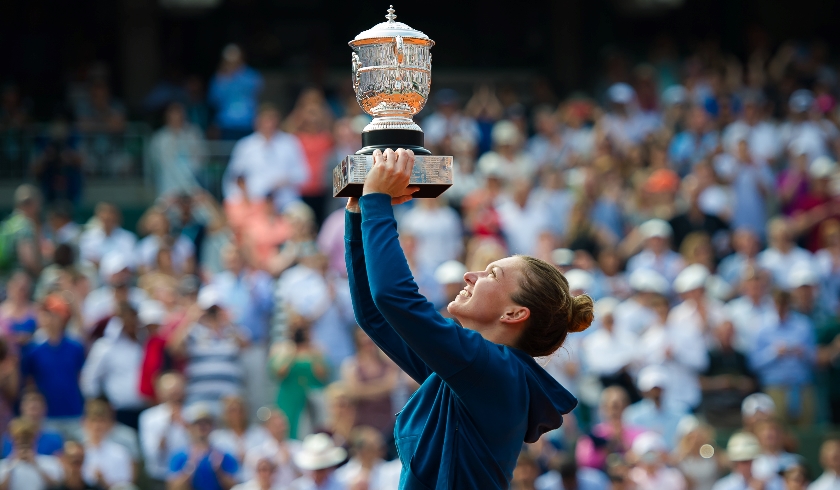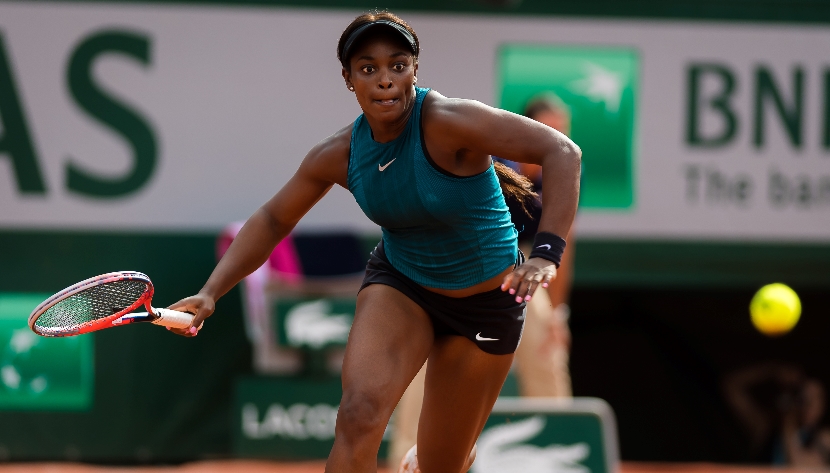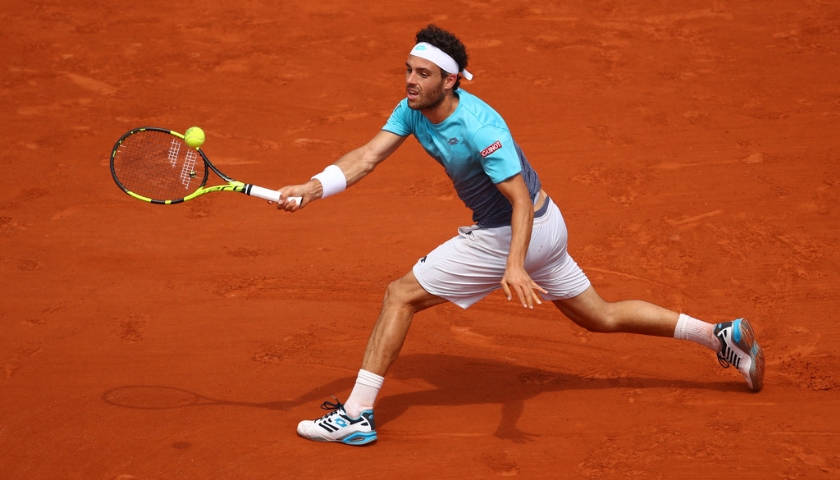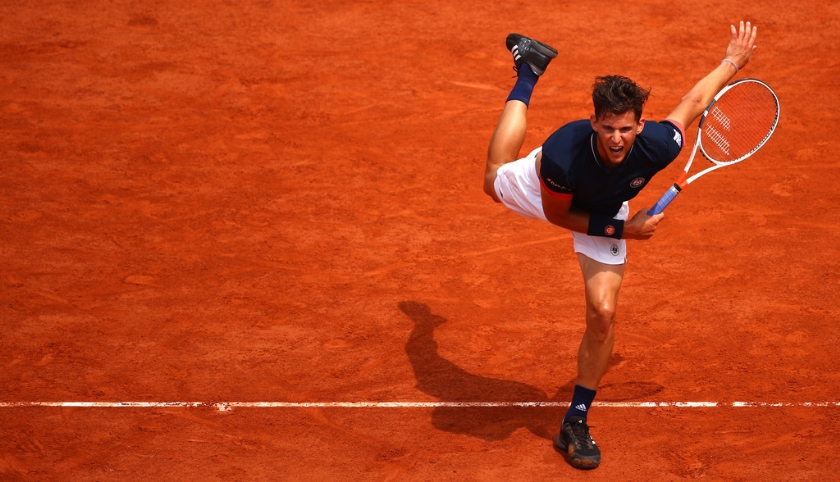Evgeniya Rodina (Q) def. Antonia Lottner (Q) 3-6 7-5 6-4
Antonia Lottner, the 21-year-old from Germany, has had a great grass-court season so far. Ranked at 128 in the WTA, she has slowly but surely began knocking on the door of a top-100 ranking for the first time in her young career. She did so, by winning four matches in s’Hertogenbosch as a qualifier – including an impressive straight-set victory over the second seed Elise Mertens (WTA no.15) – before losing in the quarterfinals to Viktoria Kuzmova.
Then, in Mallorca, she qualified again for the main draw and lost in the round of 16 to Anastasija Sevastova in three sets, after a convincing defeat over WTA no.51 Aliaksandra Sasnovich in straight sets.
She won three more qualifying-draw matches to earn her first Wimbledon main-draw appearance. With ten wins on grass in her pocket, the in-form Lottner drew Evgeniya Rodina (WTA no.120), another qualifier. It all seemed to fall into place for a great shot at a top-100 ranking and a breakthrough outing in this Major.
Except that her opponent – the 29-year-old Rodina – is a pesky competitor, a problem solver, and an experienced customer.
Lottner did begin the match on fire though. She hit three winners to break Rodina’s serve in the first game and added more from both wings until a bad game at 3-2 in which she double-faulted, framed a forehand, and sailed a backhand deep to lose her serve. Rodina went up 40-0 in the next game but Lottner came back to break and never looked back in the first set. She won it 6-3, producing 19 winners and an ace on the way.
The German kept going for her shots, making her opponent scramble and run balls down. Rodina could hardly gain any traction in rallies. The 6-foot-1-inch Lottner was serving big, nailing her forehands, even striking winners from low balls on her two-handed backhand, which required her to really bend her knees.
Don’t get me wrong, Rodina can get a lot of balls back and frustrate opponents. This defensive type of play is not a challenge from which she runs away as a player. But on grass, against a hard-hitting opponent that was clicking on all cylinders, she needed to modify her tactics. It may put her in an uncomfortable style of play, but it was necessary. And Rodina is the type of player that would definitely be on board with “uncomfortable,” if it means that it can turn the tide in her favor.
So, the Russian began to get aggressive with her groundstrokes at the cost of making more errors, which she did. After recording only six unforced errors in the first set, she made 11 in the second**. But she also began sinking her teeth into the match, because she started to take away the comfortable take-a-step-forward-and-nail-the-winner routine that Lottner had adopted since the match began.
**I do my own count of unforced errors for reasons that I have expressed many times in the past. Well, there is more coming a bit later in this piece. There are several things that stat people in counting unforced/forced errors, with which I disagree strongly. You will see me underline one of those reasons. Bear with me.
Rodina started going for bigger returns on Lottner’s serves. She also began hitting down-the-line more, to counter the way her opponent was moving into the court to cut off the cross-court ones. Lottner began finding herself chasing balls sideways (or backward) and her one visible weakness – a slow first step which makes it hard for her to change direction – began to surface. Rodina hit nine winners in the second set (vs three in the first) and that does not include the times she forced Lottner into errors because the German was having to hit bigger shots from behind the baseline, instead of hitting them from inside the court like in the first set.
None of this guaranteed a comeback for Rodina. It simply allowed her to remain on serve in the second set. In fact, at 4-5 down, Lottner had a legitimate chance to close out the match on her return game. At the 15-30 point, on a short second serve by Rodina, Lottner stepped inside the court for a winner attempt. She slammed the forehand return in the net. Rodina won the next point to go up 40-30, and held serve to equalize at 5-5, thanks to another forehand return missed in the net by Lottner.
These were not errors caused by Rodina’s good serves. Lottner missed them while attempting to go for winners. She then lost her service game – the only break of the second set – and Rodina extended the match to a third set by holding hers. In a matter of less than ten minutes, Rodina went from being two points away from losing the match in a routine straight-set affair to being leveled at one set each.
Let me pause for a moment and focus on Lottner’s forehand return errors. She had previously missed three of them in the very first game of the second set, two of which were winner attempts on Rodina’s second serves. Apparently, that was only the beginning. She continued to miss forehand returns – very makable ones – throughout the rest of the match.
It was the one glaring error-prone area in her game. I understand that putting pressure on Rodina’s serve by returning big was part of her game, but when you miss that much, should you not perhaps consider a more conservative return, one that goes higher over the net and simply lands deep by the baseline, so that you can perhaps set up your winner attempt on the next shot? Instead, she kept firing one risky forehand return after another.
And she kept missing one forehand return after another.

Lottner made ten “unforced”** forehand-return errors in the second set alone. She added eight more to the tally in the final set. I noted earlier how Rodina was willing to make the “uncomfortable” adjustment if it were necessary. Lottner was not, did not.
**Stay with me, and you will see why I have “unforced” in quotation marks.
The adjustment Rodina made after the first set ended, in the meantime, began to bear fruit. Rallies were a lot different in the third set than in the first. You no longer saw Lottner inside the court, directing rallies and finishing them off with winners that she got to strike from inside the baseline. Instead, you saw both player hitting hard in punch-to-punch rallies, and Rodina having more and more to say about their patterns. It also helped that Rodina’s first-serve percentage was at a spectacular 91% (31 out of 34) in the final set, while Lottner’s first-serve percentage got progressively worse throughout the match (73%-64%-60% for the three sets).
Rodina made ten unforced errors in the final set, which was in line with the adjustment in her aggressiveness after the first set ended. Lottner, for her part, made 16 unforced errors on her forehand alone, with eight of them being on returns. And that brings me to my last discussion point – or, my rant, I shall say.
My regular readers know how much I complain about the way unforced-error stats are kept. Double faults are counted as unforced errors sometimes, while return and passing-shot-attempt errors are never counted regardless of the circumstances. This match is a great example of how stats fail to emphasize the most significant number of this match.
You look at the official stats and you see nine forehand unforced errors for Lottner in the second set, and ten in the third. Well, my count would be closer to that, if I were NOT to count routine forehand errors made by Lottner on RETURNS.
I am sorry but if the opponent hits a mid-pace second serve that sits right there for the returner to nail a routine shot, and yet she misses it, that should get recorded as an unforced error. In fact, it is obvious that Lottner was considering them as sitters, because she would painlessly step inside the baseline and go for winners. When you add the errors that she made on those returns into the count, you get Lottner with 16 unforced forehand errors in the second set, and 15 in the third, instead of nine and ten.
More importantly, you understand that it was not forehands in general that were causing the short circuit in Lottner’s game. It was her forehand returns. The devil is in the details folks. Stats should reflect every detail that counts.
Rodina ended up winning the match 3-6 7-5 6-4 in two hours and one minute.
It was a terrific comeback by the Russian who appeared to be outmatched for almost two sets. However – and I apologize for quoting myself from earlier –, Rodina is a pesky competitor, a problem solver, and an experienced customer. The Russian is not a great athlete, but she has won many matches of this type in her career, during which she fabricates a way to turn things around against seemingly superior talent. She remains underrated in this sense, quite frankly. Here is a match – one among many in her career – where she was willing to do what is necessary, no matter how uncomfortable, and come out on top.
She will next take on Sorana Cirstea who pulled one of the early upsets of the tournament by defeating the 19th-seeded (and last year’s semifinalist) Magdalena Rybarikova in straight sets.
Until next time…








